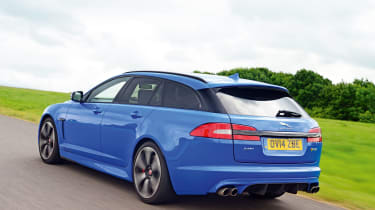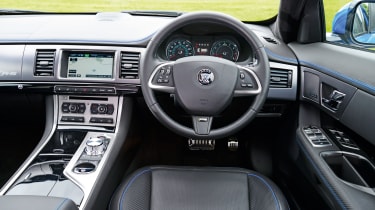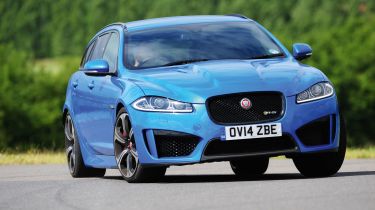Jaguar XFR-S Sportbrake (2014-2015) review
Stylish and powerful V8 XFR-S Sportbrake combines huge performance with load-carrying ability

With its stylish looks, vast boot and powerful V8 engine, the new XFR-S Sportbrake truly lives up to Jaguar’s classic fifties advertising slogan of producing cars with ‘grace, space and pace’.
Boasting the same 542bhp supercharged engine and heavily reworked suspension as the XFR-S saloon, the fast and vast newcomer promises to be one of the most exhilarating estates money can buy – although at £82,495, it’s far from cheap.
Engines, performance and drive
The 542bhp XFR-S can’t match its main rival, the Mercedes E63 AMG S Estate, for ultimate pulling power, but on a track there's little to separate the two. Thanks to the instant response from its supercharger and the well chosen ratios of its slick eight-speed automatic gearbox, the Sportbrake still has blistering pace.
No matter what gear you’re in, the Sportbrake responds sharply to throttle inputs and surges forward on a wave of torque. In fact, our only criticism is that the 5.0-litre V8 can sound a little muted. There’s a hint of whine from the supercharger and a typical V8 burble at idle, but it never sounds as purposeful when accelerating hard.
Happily there are no such complaints about the chassis. To help give the XFR-S a more focused feel, Jaguar has recalibrated the steering and heavily revised the suspension geometry. As a result, the steering has a meatier feel than the standard XF Sportbrake and delivers more useful feedback. And despite the extra weight of the estate body, it feels every bit as agile as the saloon.

Turn-in is sharp, with plenty of front-end grip, while the car’s attitude in the corner can be fine-tuned using a combination of steering and throttle. Traction isn’t an issue in day-to-day driving, but switch off the safety aids and the rear-wheel-drive Jaguar will spin up its rear wheels at the slightest provocation.
Used - available now

2021 Lexus
UX 300e
22,738 milesAutomaticElectric
Cash £16,063
2023 Peugeot
3008
27,941 milesAutomaticDiesel1.5L
Cash £18,497
2022 BMW
X1
46,719 milesAutomaticDiesel2.0L
Cash £18,097
2020 Hyundai
Ioniq hybrid
45,952 milesAutomaticPetrol1.6L
Cash £12,497Other highlights include the strong brakes, with their progressive pedal action, and the excellent automatic gearbox, which serves up silky smooth shifts in auto mode and crisp changes via the wheel-mounted paddles.
Thankfully, none of this has been achieved at the expense of ride quality which, in true Jaguar style, is remarkably composed. It’s firmer than the standard car, but the XFR-S glides across crumbling surfaces that would upset its Mercedes rival. Plus, the V8 engine is virtually silent when cruising on the motorway.
MPG, CO2 and Running Costs
Although it features fuel-saving tech, the XFR-S is still a seriously expensive car to run. Stop-start cuts the V8 at standstill, but fuel consumption will still be high. Hefty CO2 emissions of 297g/km mean that an annual tax disc will set you back £500, while predicted residuals of 38.8 per cent are disappointing.
Yet it’s not all bad news. The £82,495 Sportbrake undercuts the equivalent Mercedes E63 by £3,480 and is cheaper to run as a company car. It also comes well equipped.
Interior, design and technology
Jaguar’s designers have taken a relatively low-key approach to the XFR-S Sportbrake’s visual upgrades, but there’s no mistaking its vast performance potential. Deeper bumpers are neatly integrated into the sleek shape, as are the side skirts and ‘aeroblade’ vents set into the front wings.
Elsewhere you’ll spot the massive 20-inch alloy wheels and quad exit exhausts, plus there’s plenty of carbon fibre and gloss-black trim. These additions are more than simply cosmetic, too. For instance, the small tailgate spoiler and large diffuser below the rear bumper combine to reduce aerodynamic lift as the car nears its 186mph top speed.
The understated theme continues in the cabin, which is comfortable and beautifully appointed. The deeply sculpted seats are supportive, while contrasting blue stitching lifts what is an ageing interior.
But the Jaguar is a little unadventurous. The XFR-S feels little different from other XFs, with a plain steering wheel and plastic paddles. The dash design is looking especially dated, too, particularly the clunky graphics used for the touchscreen infotainment system.
Practicality, comfort and boot space
It's not short of performance and poise, but the Jaguar is not as practical as its most direct rivals. The low-slung roof takes its toll on carrying capacity, and with the rear bench in place the Sportbrake has 550 litres of boot space – 145 litres less than The Mercedes E-Class.

Levers in the side of the load bay allow you to easily fold the 60:40 split rear seats, increasing the available space to 1,675 litres and a flat load lip makes access easy, while the load cover rises out of the way.
Interior space is decent, but head and legroom in the rear of the XFR-S is slightly limited for taller passengers. On the plus side, there’s a decent amount of storage, including a number of lidded cubbies in the centre console.
Reliability and Safety
Given that it’s based on the standard XF, the racy XFR-S should be right up there with the best in the business when it comes to reliability. The standard saloon placed 15th in our Driver Power 2014 satisfaction survey, while Jaguar finished a superb second in the manufacturer rankings.
Like all Jaguars, the car comes with a three-year, unlimited mileage warranty. And although the requirement for a service every 16,000 miles is unusual in an era of flexible intervals, Jaguar’s dealers enjoy an excellent reputation for customer care.
Less impressive is the four-star Euro NCAP crash test score. The car was awarded this despite having six airbags and an advanced stability control system, as well as an active bonnet that pops up to protect pedestrians.







